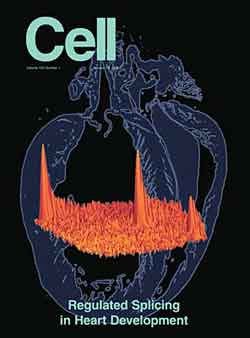UCSD Medical Researchers Discover Molecular Pathway That Turns a Juvenile Heart into an Adult Heart

Xu et al./Cell
Researchers at the University of California, San Diego (UCSD) School of Medicine have discovered the molecular sequence of events in mice that turn a juvenile heart into an adult heart capable of responding to increased workloads.
Published as the cover story in the January 14, 2005 issue of the journal Cell, the study identifies a protein called ASF/SF2 as a regulator of a calcium enzyme responsible for heart contraction and tissue growth. Mice born with mutated or absent ASF/SF2 had shortened contractive fiber that appeared locked in a contracted state, leading to sudden death. When ASF/SF2 was normal, heart development progressed normally.
“The cascade of molecular events that we have uncovered are directly relevant to understanding heart physiology during development, and may provide insights into mechanisms that directly contribute to heart attacks in humans,” said the study’s senior author, Xiang-Dong Fu, Ph.D., a UCSD professor of Cellular and Molecular Medicine.
ASF/SF2 are part of a family of proteins that function in a vital cellular process called alternative splicing – the mechanism through which a single gene can generate several kinds of proteins by selecting different combinations of the same set of amino acid building blocks. Alternative splicing occurs at all stages of development, including the period of transition from juvenile to adult life, when many tissues and organs, such as the heart, become mature. Although alternative splicing is widely known, little is understood about how this process occurs in mammals. In a “Preview” appearing in the January 14, 2005 issue of Cell, Thomas A. Cooper of the Departments of Pathology and Molecular and Cellular Biology at Baylor College of Medicine in Houston, noted that the results by Fu’s team “highlight the huge potential and largely unexplored role for alternative splicing during vertebrate development.”
The UCSD researchers used mouse models and sophisticated laboratory procedures in their studies. Mice developed without ASF/SF2 appeared normal at birth, but developed a notable decrease in heart contraction as they neared adulthood. Examining the contractile apparatus in the mutant heart, the investigators found striking structural defects, including shortened contractile tissue called sarcomeres and altered ridges in heart tissue. Follow-up functional studies at the single cell level uncovered a marked alteration in calcium handling, which is a major regulatory function for muscle contraction. Additional findings pointed to an increase in the expression of genes related to excessive cardiac tissue growth (hypertrophy) and fiber growth (fibrosis), which are indicators of a heart condition called dilated cardiomyopathy.
Interestingly, the researchers also found differences in male versus female mice. The male animals experienced greater disease and died earlier than the females with mutated ASF/SF2.
The UCSD study was funded by the National Institutes of Health (NIH). Additional authors were Xiangdong Xu, B.S., UCSD Department of Cellular and Molecular Medicine, and Dongmei Yang, Ph.D., National Institute on Aging, NIH, co-first authors; and Jian-Hua Ding, Ph.D., Huan-You Wang, Ph.D., Zhen Ye, B.S., UCSD Department of Cellular and Molecular Medicine; Wang Wang, Ph.D., Rui-Ping Xiao, Ph.D., and Heping Cheng, Ph.D., National Institute on Aging, NIH; Pao-Hsien Chu, Ph.D., Nancy D. Dalton, B.S. and Ju Chen, Ph.D., UCSD Department of Medicine and Institute of Molecular Medicine; John R. Bermingham, Jr. Ph.D., Forrest Liu, B.S. and Michael G. Rosenfeld, M.D., UCSD Department of Medicine and Howard Hughes Medical Institute; and James L. Manley, Ph.D., Department of Biological Sciences, Columbia University, New York.
Media Contact
All latest news from the category: Life Sciences and Chemistry
Articles and reports from the Life Sciences and chemistry area deal with applied and basic research into modern biology, chemistry and human medicine.
Valuable information can be found on a range of life sciences fields including bacteriology, biochemistry, bionics, bioinformatics, biophysics, biotechnology, genetics, geobotany, human biology, marine biology, microbiology, molecular biology, cellular biology, zoology, bioinorganic chemistry, microchemistry and environmental chemistry.
Newest articles

Properties of new materials for microchips
… can now be measured well. Reseachers of Delft University of Technology demonstrated measuring performance properties of ultrathin silicon membranes. Making ever smaller and more powerful chips requires new ultrathin…

Floating solar’s potential
… to support sustainable development by addressing climate, water, and energy goals holistically. A new study published this week in Nature Energy raises the potential for floating solar photovoltaics (FPV)…

Skyrmions move at record speeds
… a step towards the computing of the future. An international research team led by scientists from the CNRS1 has discovered that the magnetic nanobubbles2 known as skyrmions can be…





















